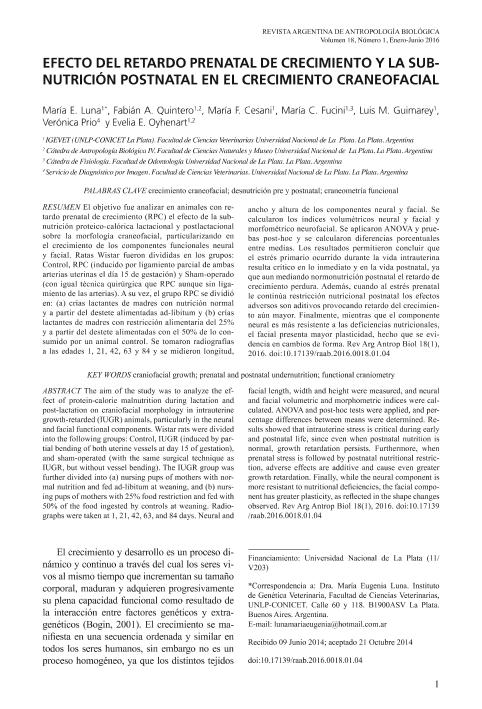Artículo
El objetivo fue analizar en animales con retardo prenatal de crecimiento (RPC) el efecto de la sub-nutrición proteico-calórica lactacional y postlactacional sobre la morfología craneofacial, particularizando en el crecimiento de los componentes funcionales neural y facial. Ratas Wistar fueron divididas en los grupos: Control, RPC (inducido por ligamiento parcial de ambas arterias uterinas el día 15 de gestación) y Shamoperado (con igual técnica quirúrgica que RPC aunque sin ligamiento de las arterias). A su vez, el grupo RPC se dividió en: (a) crías lactantes de madres con nutrición normal y a partir del destete alimentadas adlibitum y (b) crías lactantes de madres con restricción alimentaria del 25% y a partir del destete alimentadas con el 50% de lo consumido por un animal control. Se tomaron radiografías a las edades 1, 21, 42, 63 y 84 y se midieron longitud, ancho y altura de los componentes neural y facial. Se calcularon los índices volumétricos neural y facial y morfométrico neurofacial. Se aplicaron ANOVA y pruebas post-hoc y se calcularon diferencias porcentuales entre medias. Los resultados permitieron concluir que el estrés primario ocurrido durante la vida intrauterina resulta crítico en lo inmediato y en la vida postnatal, ya que aun mediando normonutrición postnatal el retardo de crecimiento perdura. Además, cuando al estrés prenatal le continúa restricción nutricional postnatal los efectos adversos son aditivos provocando retardo del crecimiento aún mayor. Finalmente, mientras que el componente neural es más resistente a las deficiencias nutricionales, el facial presenta mayor plasticidad, hecho que se evidencia en cambios de forma. The aim of the study was to analyze the effect of protein-calorie malnutrition during lactation and post-lactation on craniofacial morphology in intrauterine growth-retarded (IUGR) animals, particularly in the neural and facial functional components. Wistar rats were divided into the following groups: Control, IUGR (induced by partial bending of both uterine vessels at day 15 of gestation), and sham-operated (with the same surgical technique as IUGR, but without vessel bending). The IUGR group was further divided into (a) nursing pups of mothers with normal nutrition and fed adlibitum at weaning, and (b) nursing pups of mothers with 25% food restriction and fed with 50% of the food ingested by controls at weaning. Radiographs were taken at 1, 21, 42, 63, and 84 days. Neural and facial length, width and height were measured, and neural and facial volumetric and morphometric indices were calculated. ANOVA and post-hoc tests were applied, and percentage differences between means were determined. Results showed that intrauterine stress is critical during early and postnatal life, since even when postnatal nutrition is normal, growth retardation persists. Furthermore, when prenatal stress is followed by postnatal nutritional restriction, adverse effects are additive and cause even greater growth retardation. Finally, while the neural component is more resistant to nutritional deficiencies, the facial component has greater plasticity, as reflected in the shape changes observed.
Efecto del retardo prenatal de crecimiento y la subnutrición postnatal en el crecimiento craneofacial
Título:
Craneofacial effect of prenatal growth retardation and postnatal undernutrition in craniofacial growth
Luna, Maria Eugenia ; Quintero, Fabian Anibal; Cesani Rossi, María Florencia
; Quintero, Fabian Anibal; Cesani Rossi, María Florencia ; Fucini, Maria Cecilia; Guimarey, Luis Manuel; Prio, Maria Veronica; Oyhenart, Evelia Edith
; Fucini, Maria Cecilia; Guimarey, Luis Manuel; Prio, Maria Veronica; Oyhenart, Evelia Edith
 ; Quintero, Fabian Anibal; Cesani Rossi, María Florencia
; Quintero, Fabian Anibal; Cesani Rossi, María Florencia ; Fucini, Maria Cecilia; Guimarey, Luis Manuel; Prio, Maria Veronica; Oyhenart, Evelia Edith
; Fucini, Maria Cecilia; Guimarey, Luis Manuel; Prio, Maria Veronica; Oyhenart, Evelia Edith
Fecha de publicación:
01/2016
Editorial:
Asociación de Antropología Biológica Argentina
Revista:
Revista Argentina de Antropología Biológica
ISSN:
1853-6387
e-ISSN:
1514-7991
Idioma:
Español
Tipo de recurso:
Artículo publicado
Clasificación temática:
Resumen
Archivos asociados
Licencia
Identificadores
Colecciones
Articulos(IGEVET)
Articulos de INST.DE GENETICA VET ING FERNANDO NOEL DULOUT
Articulos de INST.DE GENETICA VET ING FERNANDO NOEL DULOUT
Citación
Luna, Maria Eugenia; Quintero, Fabian Anibal; Cesani Rossi, María Florencia; Fucini, Maria Cecilia; Guimarey, Luis Manuel; et al.; Efecto del retardo prenatal de crecimiento y la subnutrición postnatal en el crecimiento craneofacial; Asociación de Antropología Biológica Argentina; Revista Argentina de Antropología Biológica; 18; 1; 1-2016; 1-9
Compartir
Altmétricas



